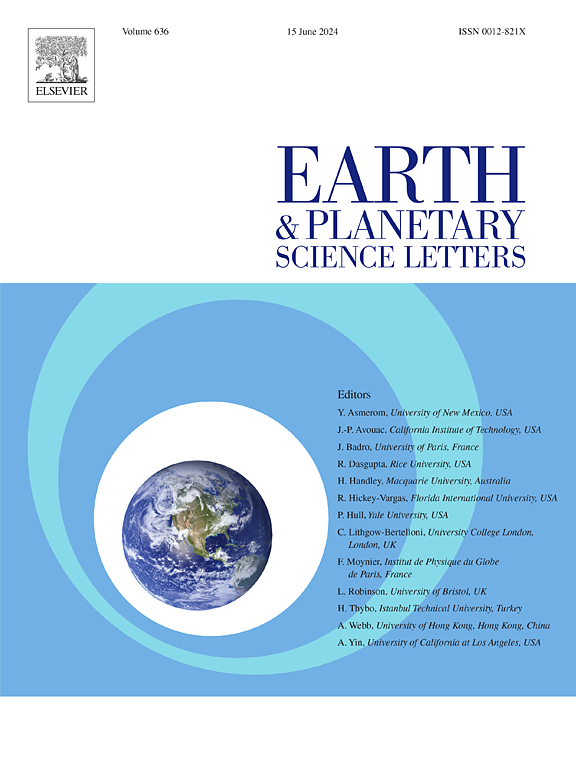Modern-like seawater δ18O in the mesoproterozoic: Insights from triple oxygen isotopes of chert
IF 4.8
1区 地球科学
Q1 GEOCHEMISTRY & GEOPHYSICS
引用次数: 0
Abstract
Oxygen isotope compositions in ancient seawater (δ18OSW and Δ’17OSW) are key proxies for deciphering past climate and tectonic regimes. Despite various reconstruction attempts, a consensus on their history remains elusive. Chert, valued for its diagenetic stability, offers a promising archive, particularly through triple oxygen isotope analysis. However, Precambrian cherts frequently exhibit deviations in δ18O and Δ’17O from triple oxygen isotope equilibrium, complicating interpretations. Here, we propose that this deviation results from the coprecipitation of oxygen-bearing minerals (detrital silicates, authigenic clays, and barite), each with distinct isotopic signatures. To test this hypothesis, we analyzed Mesoproterozoic chert samples from the Yangzhuang and Wumishan formations in North China. Our results show a significant correlation between chert δ18O and detrital silicate content, with coexisting oxygen-bearing minerals driving deviations in δ18O and Δ’17O from equilibrium. The δ18O and Δ’17O values of the purest, most pristine chert samples suggest that Mesoproterozoic seawater had a δ18O similar to that of modern seawater (i.e. ∼ -1 ‰, ice free world seawater), a conclusion further supported by our oxygen balance model. This study demonstrates that using pure chert or an oxygen balance model is essential for accurately reconstructing ancient δ18OSW.
中元古代现代海水δ18O:来自燧石三氧同位素的启示
古海水的氧同位素组成(Δ 18osw和Δ’17OSW)是破译过去气候和构造机制的关键指标。尽管有各种重建尝试,但对它们的历史仍难以达成共识。由于其成岩稳定性而受到重视,特别是通过三氧同位素分析,提供了一个有前途的档案。然而,前寒武纪燧石的Δ 18o和Δ ' 17O经常偏离三氧同位素平衡,使解释变得复杂。在这里,我们提出这种偏差是由含氧矿物(碎屑硅酸盐,自生粘土和重晶石)的共沉淀造成的,每种矿物都具有不同的同位素特征。为了验证这一假设,我们分析了中国北部杨庄组和雾雾山组中元古代燧石样品。结果表明,燧石Δ 18o与碎屑硅酸盐含量具有显著的相关性,共存的含氧矿物导致Δ 18o和Δ ' 17O偏离平衡。最纯净、最原始的燧石样品的Δ 18o和Δ’17O值表明,中元古代海水的Δ 18o值与现代海水(即~ -1‰,无冰世界海水)相似,氧平衡模型进一步支持了这一结论。研究表明,使用纯燧石或氧平衡模型是准确重建古δ18OSW的必要条件。
本文章由计算机程序翻译,如有差异,请以英文原文为准。
求助全文
约1分钟内获得全文
求助全文
来源期刊

Earth and Planetary Science Letters
地学-地球化学与地球物理
CiteScore
10.30
自引率
5.70%
发文量
475
审稿时长
2.8 months
期刊介绍:
Earth and Planetary Science Letters (EPSL) is a leading journal for researchers across the entire Earth and planetary sciences community. It publishes concise, exciting, high-impact articles ("Letters") of broad interest. Its focus is on physical and chemical processes, the evolution and general properties of the Earth and planets - from their deep interiors to their atmospheres. EPSL also includes a Frontiers section, featuring invited high-profile synthesis articles by leading experts on timely topics to bring cutting-edge research to the wider community.
 求助内容:
求助内容: 应助结果提醒方式:
应助结果提醒方式:


